Lower back pain affects a significant portion of the population, with up to 80% experiencing it at some point in their lives. Muscular weakness and core instability are often the culprits behind lower back pain, but at-home exercises can help alleviate it.
Discover the best exercises for lower back pain and why using Tonal can be an effective way to reduce it, with personalized weight recommendations and form guidance. Before starting any new exercise routine, it’s important to consult with a medical provider if you’re currently experiencing pain.
What Causes Lower Back Pain?
Lower back pain can have various causes, including conditions that affect older adults and acute or chronic strains in muscles or tendons. Additionally, biomechanical issues such as poor form and positioning can contribute to discomfort.
Overtraining and taking on too much volume too quickly can also worsen lower back pain. Tonal offers guided programs that gradually increase volume and provide consistent feedback on a form to promote good posture and alignment, making it a helpful tool for those with lower back pain. However, it’s important to consult with a medical professional before starting any new exercise routine.
Strengthening and stabilizing the muscles and joints that support the back can help improve your posture and reduce the load on your spinal muscles. As Tonal coach and certified personal trainer Kristina Centenari explains, limited spinal mobility, lack of core strength and stability, and weak hip flexors, glutes, or hamstrings may all lead to lower back pain.
While conditions like degenerative disk disease and osteoporosis are best managed under the care of a doctor or physical therapist, there are at-home back exercises you can try to address the mobility issues and muscle weaknesses that commonly cause pain.
Here are Centenari”s and Landicho’s picks for the best exercises to relieve lower back soreness.
Spinal Mobility Exercises for Lower Back Pain
To see if a lack of spinal mobility is the cause of your back pain, Centenary describes three simple tests:
- Rotate your torso side-to-side while keeping your hips stable
- Bend from side to side with your arms straight at your side
- Arch and round your back.
If you feel pain or restriction in any of these positions, you may be dealing with a lack of spinal mobility and could benefit from the two moves below.
1. Half-Kneeling Spinal Rotation
Why it Works: To slowly reintroduce healthy mobility to your spine, Centenari recommends this gentle twisting movement. “Once you feel good, you can start to twist a little bit more,” she says. “It’s pretty simple but quite effective.”
How to Do it: In a half-kneeling position with one foot down and the opposite knee forward, place both hands behind your head. Breathe deeply as you gently rotate from one side to the other.
2. Cat-Cow

Why it Works: If you’re feeling pain when you arch and round your back (positions called extension and flexion respectively), Landicho recommends this move. “It can give someone gradual exposure to the provocative position, but they’re able to do it in a safe and controlled way.” He suggests trying it out if you experience pain during deadlifts.
It’s also a favorite of Centenari: “Each vertebra should ideally be able to move on its own like a wave,” she says, “but as we get older they get stickier and stickier from a lack of training.” As you do the cat-cow stretch, she recommends moving slowly and imagining your vertebrae moving individually in a wave pattern as your back loosens up.
How to Do it: Start on all fours on your mat, knees under your hips, wrists under your shoulders, and toes tucked. Inhale and open your chest, dropping the navel toward the floor and arching your back. Exhale and push the navel toward the ceiling, pushing the floor away from you and pulling the shoulder blades apart as you tuck the hips.
On Tonal, Landicho recommends a coach-led mobility session, such as Back Mobility Clinic with Coach Liz Letchford, in which you’ll learn how to access pain-free movement in your spine. You can also try the moves below to improve your range of motion.
Core Exercises for Lower Back Pain
A strong and stable core helps support the lower back and prevent pain. And the “core” we’re talking about here goes beyond the abs.
“It’s not just the front [of your torso]; it wraps around and hits the muscles that line your vertebrae,” says Centenary. Think about what happens if you try to reach up to a high cabinet with weak core muscles: You’ll likely overextend your back putting more stress on your spine. “Those little muscles around your vertebrae aren’t meant to handle a lot of loads,” says Centenary.
To test if a weak core is the source of your lower back pain, get into a high plank position and bring one hand at a time to the opposite shoulder. If you can’t do this without keeping your hips from moving, you’re likely lacking core strength. The moves below will help build the strength and stability needed to support your back.
1. Pillar Bridge

Why it Works: The basic pillar bridge is one of Centenari’s favorite core exercises. She says to imagine balancing a glass of water or a tennis ball on your back to practice keeping your hips stable. If you’re struggling, try moving your feet farther apart: “The wider your feet are, the easier it is to keep your hips still,” she says.
How to Do it: Get onto your mat facing the floor with both elbows under your shoulders and feet hip distance apart, toes tucked. Lift the knees to extend the legs and push the floor away from you through your elbows.
2. Shoulder Tap Plank

Why it Works: In addition to serving as a method for evaluating your core stability, this move is actually a great way to improve it and one of the best exercises for lower back pain. If you’re still experiencing hip movement when you tap your shoulder, try just holding the high plank position at first and then progress too slowly lifting one arm or leg at a time.
How to Do it: Place your hands on your mat, shoulder width apart. Extend your legs behind you with your feet hip distance apart, toes tucked. Lift one hand and tap the opposite shoulder, then drop it back down to the floor and alternate sides. Keep your torso from moving, as if you’re balancing a glass of water on your back.
3. Farmer March

Why it Works: Once you’re ready to add resistance to your core work, Centenari likes this exercise for lower back pain because it trains your core and trunk to stabilize against resistance. Balancing on one leg at a time while carrying a load mimics everyday activities that can overtax your back. “Ever feel your back fatigue when carrying home heavy groceries? This will help,” she says.”
How to Do it: Stand between Tonal’s arms. Take a handle in each hand with your arms at your side. Slowly drive one knee up to hip height, balancing on the opposite leg. Return to the starting position and alternate legs.
4. Bird Dog With Row

Why it Works: Along with requiring core stability in an uneven position, this move strengthens your back muscles with the addition of a row. Centenary says it’s key for building anti-rotational and anti-lateral core strength, priming your body to resist being pulled in different directions which is stressful on the back.
How to Do it: Get onto all fours on your bench with your wrists under your shoulders and your knees under your hips. Lift one leg toward the ceiling and grab the handle with the opposite arm, balancing on the limbs. Using your back, pull the handle toward your ribcage aiming your elbow to the ceiling. Control the weight back down and repeat on the same side.



